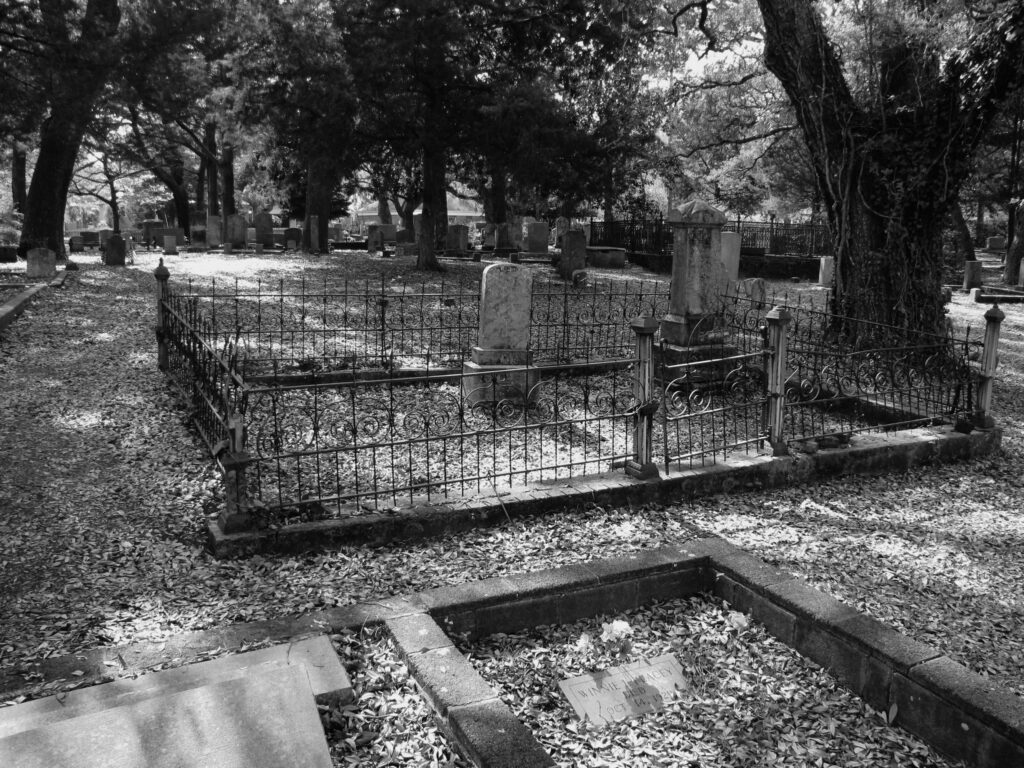
A few weeks ago, our family took a trip to the beach. It’s an annual ritual when our health and schedule afford it. We try to look for activities, but mostly we take it easy and enjoy the ocean and the slower pace of life. This year we were interested in doing a ghost walk around the nearby town of Southport. Southport has a history going back to the 1700s and is ripe for hauntings. We did the Southport ghost walk about 15-20 years prior and were pleased to discover that the same woman who had just started it at the time of our first encounter was still leading the tour. Katie Stewart holds a degree in Antebellum Southern and North Carolina history and a long-time resident’s passion for the town’s old stories.
About midway through our stay at the beach, I was able to hang out with one of my favorite colleagues (in truth, I like all my colleagues), who was also on a family trip at the same time. When I told his wife we were doing a ghost walk, she was intrigued. Their family had been in Southport the day before. She told me that they visited an antique shop in the town, and she had felt a negative presence on the second floor of the shop. It was so strong that she had to leave. She confessed to being sensitive to paranormal activity, and that wasn’t the first such experience for her.
A couple of days later, our family met at Whittler’s Bench, the Southport landmark that serves as the origin point for the ghost walk. Our first stop on the walk was a place that wasn’t included the last time we participated. The place was an antique shop called Northrop Antique Mall. The storefront looked the part, with large gold lettering on an elegantly faded green painted background and large windows cluttered with sentimental items to lure potential shoppers. The story was that a former proprietor of the business (before it was an antique shop) had lost most of his money in the Great Depression. He spent his subsequent years holed up on the second floor of the business in the company of whiskey and cigars. Eventually, he put a gun to his head and pulled the trigger. The front window facing the street has a splatter pattern that won’t allow itself to be scrubbed away.
After hearing the story of Mr. Northrop, I gave my wife a knowing look. It was a spooky start to the walk, which otherwise was a pretty standard affair, as these things go. When the tour concluded, I lingered to speak with our guide. I told her about the experience my colleague’s wife had in an antique store but didn’t know if it had been the same one as the first stop on the tour. She assured me it could be none other, since there was only one antique store with a second story in the town.
Upon my return to the office, I told several of my coworkers about my paranormal experience. One asked me if I was superstitious. I answered in the negative, as I certainly don’t consider myself to be such. I don’t carry around a lucky rabbit’s foot, and even the soldier’s cross I wear around my neck is not meant as any kind of talisman. However, truthfully, I do believe in a metaphysical reality that exists beyond our everyday senses.
In fact, I worry about how our culture gets the supernatural wrong. It seems like the topic gets more attention than ever, but rarely is it reflected on honestly. My wife was just reading to me from a story on Yahoo! News about a movie on Netflix called KPop Demon Hunters. The movie sits comfortably at the # 2 spot for most streamed movies on the platform globally. In it, an all-girl K-pop group upholds the barrier between a dark underworld and our own through the power of their singing.
Outside animated movies for streaming networks, it’s not K-pop that keeps the demons at bay, though, but the power of prayer and the fruits thereof. Concern for our neighbors and a careful stewardship that allows all to get their share in reverence for the God of creation is what wards off demons.
As I was fed more quotes from the article about the new animated movie, one praising a musical single from it that was gaining popularity stuck out to me.
“A song like ‘Golden,’ it’s an ‘I Want’ song, which a lot of great pop songs are. Those coming-of-age songs, where it’s like, ‘I started from nowhere, I was the loser and now I’m the king,” Appelhans explains, referencing early ’00s Kanye West raps as an example of what he wanted to accomplish. “It’s so archetypal pop.”
Celebrations of what “I Want” are precisely what invites the demons in. Aspirations to power over others are what the demons feed on. Contentment starves the demons. Gratitude for your circumstances is fallow ground for evil spirits. Our culture seems to have this completely backwards, and the manifestations of this mentality are obvious. We see it in what we celebrate, in our politics, and in the drive to consume that only threatens to turn back and devour us like some capitalist ouroboros.